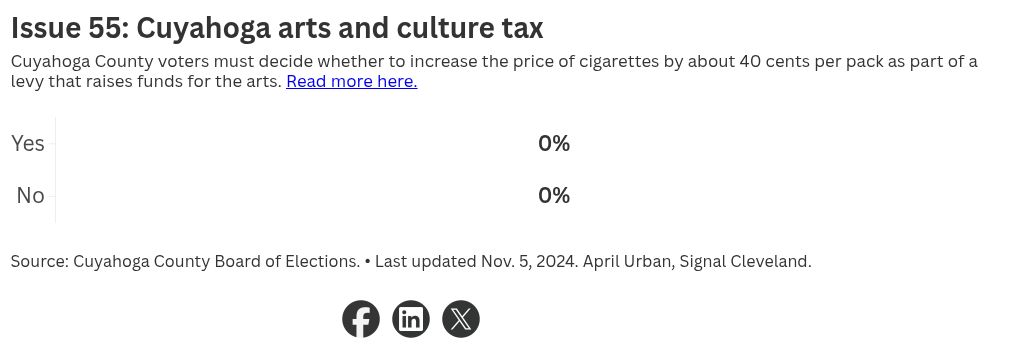Cuyahoga County voters must decide on a cigarette tax that will continue to provide arts and culture funding in Cuyahoga County.
Results will be updated when the polls close.
The 10-year tax would raise $160 million for Cuyahoga Arts & Culture (CAC), which makes grants to nonprofits arts organizations ranging from well-known arts institutions to community-based groups. CAC is an independent political subdivision. Though the Cuyahoga County executive nominates members of CAC’s board and Cuyahoga County Council appoints them, the board operates independently from the county.
The tax, which would be effective Feb. 1, 2025, would add up to 3 1/2 cents on each cigarette or 70 cents on a pack of cigarettes. Cuyahoga voters first passed a tax on cigarettes in 2006 to create ongoing arts and culture funding. Since then, the tax has raised $260 million, about 95% of which has been used for grants, according to CAC.
The new tax would replace one that currently raises about 30 cents per pack of cigarettes, though it will raise less money than when the first cigarette tax passed because of declining cigarette sales.
“Prior to 2006, Cuyahoga County did not have a dedicated public funding stream for arts and culture,” Issue 55 spokesperson Jeff Rusnak, president and CEO of R Strategy Group, said prior to Election Day. “We were near the bottom in the country in terms of the public investment in arts and culture. And now we’re one of the top.”
He said having steady funding for arts and culture has been good for the local economy. He said these benefits include creating jobs by strengthening arts and cultural institutions and boosting local tourism.
“When you ask people why they come to Cleveland time and time again, one of the top reasons is because of our robust arts and culture scene here,” Rusnak said.
He said having a strong arts community also has other benefits, including increasing the academic achievement of students, which several studies show can occur. The tax funds arts and cultural offerings for people who wouldn’t normally participate because of such things as cost or lack of exposure to programming, much of which has been inaccessible to many. Rusnak said that nearly half of the CAC-funded programs have been free.
Having a strong arts community is also a quality of life issue, he said.
“Over the years, 485 different organizations have received grants,” Rusnak said. “Because of this, you have young people going to The Music Settlement or the Children’s Museum or participating in a play or an after-school program at Cleveland Public Theater. You have them getting to go to a concert at Severance Hall or a performance at Playhouse Square. You really see how that impacts folks and how this investment really does pay off for people.”
Because of lower cigarette sales, the tax is expected to bring in about $16 million annually contrasted with the $20 million a year it raised in the years after it first passed, he said. Rusak said $16 million annually is “still a significant investment.” He wouldn’t say whether CAC was looking for ways to offset the financial loss due to lower cigarette sales.
“It would be premature to talk about looking at an additional funding source at this point,” Rusnak said.


